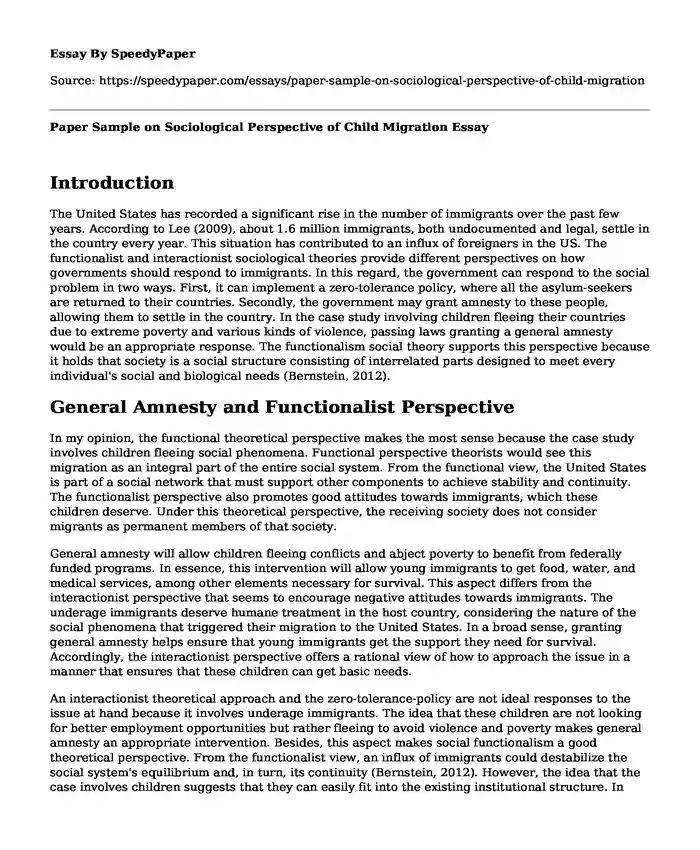
| Type of paper: | Essay |
| Categories: | United States Immigration Child development |
| Pages: | 3 |
| Wordcount: | 631 words |
Introduction
The United States has recorded a significant rise in the number of immigrants over the past few years. According to Lee (2009), about 1.6 million immigrants, both undocumented and legal, settle in the country every year. This situation has contributed to an influx of foreigners in the US. The functionalist and interactionist sociological theories provide different perspectives on how governments should respond to immigrants. In this regard, the government can respond to the social problem in two ways. First, it can implement a zero-tolerance policy, where all the asylum-seekers are returned to their countries. Secondly, the government may grant amnesty to these people, allowing them to settle in the country. In the case study involving children fleeing their countries due to extreme poverty and various kinds of violence, passing laws granting a general amnesty would be an appropriate response. The functionalism social theory supports this perspective because it holds that society is a social structure consisting of interrelated parts designed to meet every individual's social and biological needs (Bernstein, 2012).
General Amnesty and Functionalist Perspective
In my opinion, the functional theoretical perspective makes the most sense because the case study involves children fleeing social phenomena. Functional perspective theorists would see this migration as an integral part of the entire social system. From the functional view, the United States is part of a social network that must support other components to achieve stability and continuity. The functionalist perspective also promotes good attitudes towards immigrants, which these children deserve. Under this theoretical perspective, the receiving society does not consider migrants as permanent members of that society.
General amnesty will allow children fleeing conflicts and abject poverty to benefit from federally funded programs. In essence, this intervention will allow young immigrants to get food, water, and medical services, among other elements necessary for survival. This aspect differs from the interactionist perspective that seems to encourage negative attitudes towards immigrants. The underage immigrants deserve humane treatment in the host country, considering the nature of the social phenomena that triggered their migration to the United States. In a broad sense, granting general amnesty helps ensure that young immigrants get the support they need for survival. Accordingly, the interactionist perspective offers a rational view of how to approach the issue in a manner that ensures that these children can get basic needs.
An interactionist theoretical approach and the zero-tolerance-policy are not ideal responses to the issue at hand because it involves underage immigrants. The idea that these children are not looking for better employment opportunities but rather fleeing to avoid violence and poverty makes general amnesty an appropriate intervention. Besides, this aspect makes social functionalism a good theoretical perspective. From the functionalist view, an influx of immigrants could destabilize the social system's equilibrium and, in turn, its continuity (Bernstein, 2012). However, the idea that the case involves children suggests that they can easily fit into the existing institutional structure. In other words, young immigrants can easily be absorbed and integrated into the social system. This situation helps ensure that migration to the US would neither cause a social change nor threaten the social network's equilibrium.
Conclusion
The functionalist school of thought provides a sound approach to immigration involving underage immigrants. This model promotes good attitudes towards asylum-seekers, who should be absorbed and integrated into the system. Here, this aspect helps ensure that social systems are not overwhelmed, and immigrants do not cause a social change. Offering general amnesty allows young immigrants to access social services that enhance their well-being.
References
Bernstein, D. (2012). Immigrants and society - A critical view of the dominant School of Israeli sociology. The British Journal of Sociology, 31(2), 246.
https://doi.org/10.2307/589690
Lee, C. (2009). Sociological theories of immigration: Pathways to integration for US immigrants. Journal of Human Behavior in the Social Environment, 19(6), 730-744.
https://doi.org/10.1080/10911350902910906.
Cite this page
Paper Sample on Sociological Perspective of Child Migration. (2024, Jan 11). Retrieved from https://speedypaper.net/essays/paper-sample-on-sociological-perspective-of-child-migration
Request Removal
If you are the original author of this essay and no longer wish to have it published on the SpeedyPaper website, please click below to request its removal:
- Essay Example: Trump and Hillary Debate
- Between The World and Me - Literary Essay Sample for Free
- Essay Sample: Feminism, Freedom and Identity in "The Awakening"
- Violent Video Games Should Be Banned - Essay Example
- Free Essay Sample - Gaining Trust With Cultural Disparities
- Free Essay Example - Communication and Disability
- Free Essay Example on Slowly Towards the North
Popular categories




